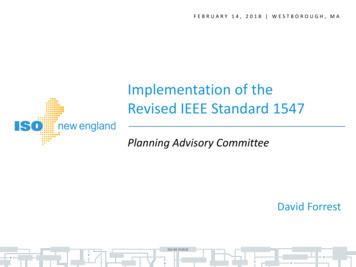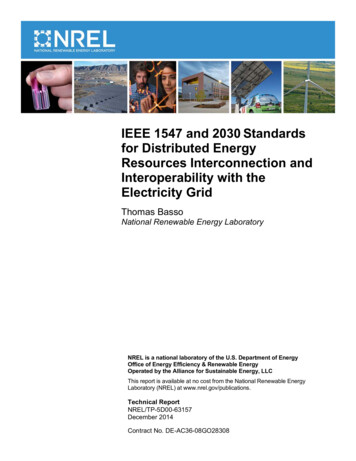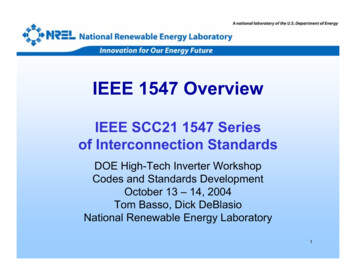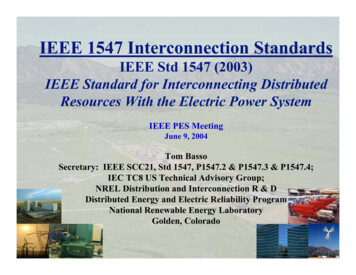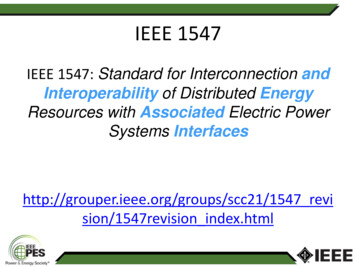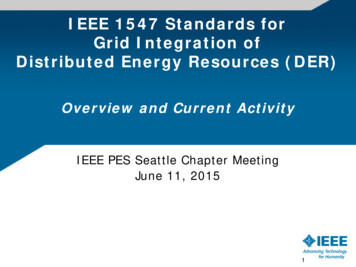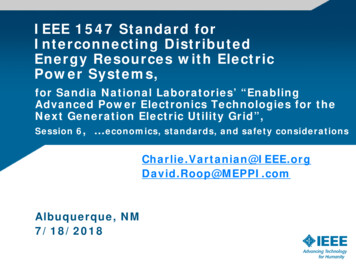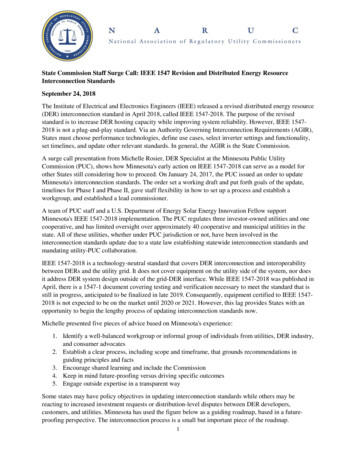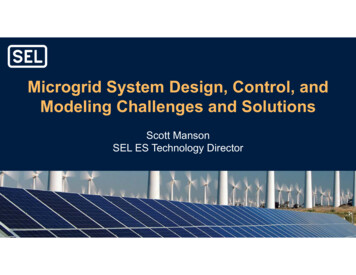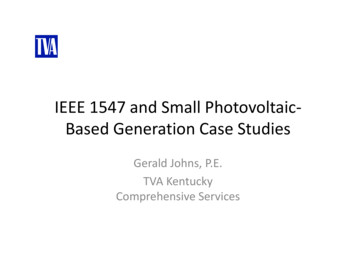
Transcription
IEEE 1547 Unintentional Islanding Protection forBiogas Power Generation FacilitiesTimothy HedquistDirector of Standards and DevelopmentCaterpillar, Inc.August 2012
IEEE 1547 Unintentional Islanding Protection for Biogas Power Generation FacilitiesABSTRACTDistributed generation (DG) facilities need a dependable, cost-effective means of providingprotective functions for the connected utility and utility customers to comply with the IEEE 1547,Standard for Interconnecting Distributed Resources with Electrical Power Systems. While thisneed applies to all DG providers, it is most keenly felt today by biogas to energy providers, whouse large reciprocating engines to generate electric power. This paper addresses the challengingunintentional islanding protection requirements using the techniques defined under US PatentApplication 12/967,688.Caterpillar Electric Power2
IEEE 1547 Unintentional Islanding Protection for Biogas Power Generation FacilitiesINTRODUCTIONThe majority of distributed generation resources are small, privately owned electric powergenerators that are connected to a utility grid at various locations to augment utility generationcapacity. Biogas power generation facilities are one example of distributed generation resources.CO2 and methane gases are extracted from a landfill or digester, taken through a process ofcleaning, drying and pressurization, and then used as fuel for a reciprocating gas engine. Thisengine drives an electric power generator, producing electricity that is sold to the local utilitythrough a connection to the power grid. Biogas power generation is considered anenvironmentally friendly technology, since emissions resulting from the combustion of CO2 andmethane are far less detrimental than the traditional practice of releasing these gases into theatmosphere.The importance of distributed generation systems is clearly recognized, but as these resourcescontinue to make inroads into the bulk power system, guidelines are needed to stipulate how theyconnect to it. To this end, the Institute of Electrical and Electronic Engineers (IEEE) worked withthe United States Department of Energy (DOE) to develop the IEEE 1547 standard, whichprovides a set of criteria and requirements in the U.S. for the interconnection of distributedgeneration resources into the utility power grid.This standard was approved by the IEEE Standards Board in 2003, after which it received anAmerican National Standards Institute (ANSI) designation. Further updates to the standard wereaffirmed in 2005 and 2008. By following the requirements of IEEE 1547, distributed powerproducers can improve the safety of their installations, minimize equipment risks, and reduceservice interruptions to utility customers while interconnected to the utility power grid.DESCRIPTIONThe IEEE 1547 standard covers a wide range of requirements for interconnecting distributedresources (DR) with electric power systems (EPS). By and large, compliance with mostrequirements can be achieved using traditional means without incurring significant additional cost,such as the protective features offered by conventional utility-grade protective relays. However,there is one IEEE 1547 requirement that could add significant cost to an installation: protectionagainst unintentional islanding. An unintentional island is formed when distributed generationcontinues to energize a portion of the utility power grid that the local utility has de-energized. Thispaper provides a cost effective solution for the detection of an islanding condition in a biogaspower generation facility.Caterpillar Electric Power3
IEEE 1547 Unintentional Islanding Protection for Biogas Power Generation FacilitiesFigure 1 – Normal Distributed Resource OperationUnder normal conditions as shown in Figure 1, distributed resources such as biogas powergeneration facilities are attached to the local utility grid through their respective points of commoncoupling (PCC), e.g. generator circuit breakers, and export power to augment utility generationcapacity. Depending on the magnitude of utility customer loads, the utility may supply power tothe local utility grid, or some of the power generated by the distributed resource may be exportedto the greater utility grid through a utility substation.Figure 2 – Unintentional IslandCaterpillar Electric Power4
IEEE 1547 Unintentional Islanding Protection for Biogas Power Generation FacilitiesAs shown in Figure 2, an unintentional island is formed when the utility substation switch isopened for reasons such as protection or maintenance, and the distributed resource continues topower the local utility grid.Section 4.4.1 of the IEEE 1547 standard states: “For an unintentional island in which the DRenergizes a portion of the Area EPS through the PCC, the DR interconnection system shall detectthe island and cease to energize the Area EPS within two seconds of the formation of an island.”Under most conditions, when significant amounts of power are imported or exported through thesubstation switch, the detection of an unintentional island by the distributed resource is simple. Inthese instances, the opening of the utility substation switch will impose a step change indistributed resource kilowatt (kW) or kilovar (kVAR) output. In turn, this step change will cause astep change in distributed resource output voltage or frequency. Conventional protective means,such as over/under voltage protection (ANSI Device 27/59) or over/under frequency protection(ANSI Device 81 O/U), will trip the PCC and de-energize the area electric power system (EPS)within 2 seconds to eliminate the unintentional island.Figure 3 – Total DR Power equals Total Utility Customer LoadsHowever, there is one unintentional island scenario that is very difficult to detect. This can occurwhen distributed resource output exactly equals the utility customer loads being served on thelocal utility grid. For the example shown in Figure 3, the output of the distributed resource exactlyequals the power needs of the utility customers on the local utility grid.Under the scenario depicted in Figure 3, there is no real or reactive power flow through the utilitysubstation switch. If the utility substation switch were opened under this condition, there wouldbe no step change in either kW or kVAR demand on the distributed resource, and the means ofconventional protection would see no change in voltage or frequency. An unintentional islandwould be formed, and the distributed resource would not sense the unintentional island condition.Caterpillar Electric Power5
IEEE 1547 Unintentional Islanding Protection for Biogas Power Generation FacilitiesTRADITIONAL SOLUTIONSThe solutions listed below provide examples of unintentional islanding protective functions, butthey do not include all available passive protection means.Solution #1Change in Frequency over Change in Time ( F/ T) – Early after the publication of IEEE 1547,some protective relay manufacturers attempted to meet the need for unintentional islandingprotection by furnishing a F/ T protective function. This protective function looks for small stepchanges in frequency over time to detect an unintentional islanding condition.This passive protective function offers additional protection against unintentional islanding, but itcannot protect against the scenario described in Figure 3. Under the Figure 3 scenario, no stepchange in distributed resource frequency will be realized, and the F/ T function will notgenerate a PCC trip.Solution #2Direct Transfer Trip (DTT) – Through this traditional means of insuring that an unintentional islandis not formed, a signal is sent from the utility substation instructing the distributed resource to tripthe PCC/circuit breaker. The installation and maintenance of DTT is expensive for the utility, andthis expense is often transferred to the biogas power producer. With the high capitalexpenditures for the biogas power producers to incorporate DTT, there are instances when anegative profit picture exists, dissuading the biogas power producer from participating.IV. ACTIVE PROTECTION FOR BIOGAS DISTRUBUTED RESOURCESSection 8.4.3.1.5 of the IEEE 1547.2 standard states: “In some cases, reactive scheme protectioncan be fooled if the generator is able to carry the load of the island without a substantial changein voltage or frequency. Some inverter manufacturers have added an additional ‘active’ nonislanding compatibility.”To better detect an islanding condition, many utilities require DTT unless an active alternative forunintentional islanding detection/protection is provided. Active islanding detection methods havebeen successfully applied to inverter-based DGs, but they have not been available for use inengine-driven generator set DGs until now.In the continental U.S., there are several assumptions that impact the implementation of costeffective IEEE 1547 unintentional islanding protection:1. Utility frequency will vary approximately /- 0.03 Hertz under normal operations.2. A distributed resource is of insufficient power to impact utility frequency.3. Due to item 2 above, the distributed resource will always be at utility frequency when inparallel with the utility source.4. Under unintentional islanding conditions, the distributed resource can change thefrequency of the EPS.5. When a distributed resource is in parallel with a stiff utility, any attempt to change enginespeed (frequency) will result only in a change in generator load, not frequency.6. When a distributed resource is islanded, a change in engine speed will result in a changein EPS frequency.Under these assumptions, imposing a “push-pull” on engine speed bias effectively provides anactive means of detecting an unintentional island condition. For normal operating conditionswhen the distributed resource is in parallel with the utility source, there will be no change infrequency. In an unintentional island condition, the speed bias push-pull will cause a change inCaterpillar Electric Power6
IEEE 1547 Unintentional Islanding Protection for Biogas Power Generation Facilitiesdistributed resource frequency, which can be captured to drive an unintentional island trip of thedistributed resource PCC/circuit breaker.For biogas power generation sites, profitability depends upon consistent engine-generator outputpower. Therefore, the push-pull of engine speed bias must be gentle enough not to negativelyimpact power production, but strong enough to move generator frequency outside limits and tripthe engine-generator circuit breaker/PCC in an unintentional island condition.For sites in the continental US, utility frequency variance is about 0.03 Hertz. Therefore, anunintentional island trip point of 0.05 Hertz (59.95 to 60.05 Hertz) will prevent spurious trips ofthe distributed resource while capturing any unintentional island condition and tripping thedistributed resource circuit breaker.In addition to this protection, a F/ T function is included to capture steps or drifts in utilityfrequency that would indicate an unintentional island or utility conditions outside of normal,expected operating parameters.Figure 5 – Unintentional Island TripFigure 5 illustrates an actual example of an unintentional island trip recorded on Cat ET software.The push-pull of desired engine speed causes corresponding changes to the position of theengine throttle. Under normal conditions, this causes little change to generator power output.When an unintentional island is formed, the desired engine speed push-pull causes an excursionin engine speed and therefore generator frequency. This excursion is captured by the IEEE 1547unintentional island protective function and a trip signal is sent to the PCC/circuit breaker.Caterpillar Electric Power7
IEEE 1547 Unintentional Islanding Protection for Biogas Power Generation FacilitiesWithout an active function to bias engine speed, an unintentional islanding condition could not bedetected if real or reactive power is not transferred across the utility substation switch. Under FileNo. 333738, Project 09CA48164, United Laboratories has certified that Cat G3500 generator setscomply with the unintentional islanding protection requirements of IEEE 1547 when operating atminimum recommended load and maximum recommended load at power factors from 0.90lagging to unity. UL compliance required the successful execution of 15 consecutive tests atvarious generator set loads and power factors.IMPLEMENTATIONDue to variances in utility frequency stability and individual engine-generator dynamics, theimplementation of IEEE 1547 unintentional islanding protection requires the following steps:1. Observation of “normal” frequency variations by the local utility over time.2. Establishment of protective function setpoints to accommodate normal utility frequencyvariations with enough margin to eliminate spurious PCC trips.3. Calculation of sufficient push-pull bias for a specific engine-generator to insure PCC tripon an unintentional island condition, and minimization of operational engine-generatoroutput variations.4. A protection test plan that local utilities can execute to assure the functionality of theIEEE 1547 unintentional islanding protection.SUMMARYWhen used in place of DTT strategies, Cat switchgear configured for IEEE 1547 unintentionalislanding protection can reduce the capital expenditure for biogas power providers. At the sametime, this protection can benefit local utilities by eliminating their need to install and maintain DTTinfrastructures.To learn more from your local Cat dealer about unintentional islanding protection and other issuesin power generation, visit www.catelectricpowerinfo.com/gas.###LEXE0255-02 August 2012This document is the property of Caterpillar Inc. and/or its subsidiaries. It may be used only tosupply goods and/or services to them and must be returned upon request. The informationhereon must be maintained in confidence and may not be reproduced, copied, or have otherdocuments prepared therefrom and may not be disclosed to others in whole or in part withoutprior written consent.CAT, CATERPILLAR, their respective logos, "Caterpillar Yellow" and the “Power Edge” tradedress, as well as corporate and product identity used herein, are trademarks of Caterpillar andmay not be used without permission. 2012 Caterpillar All Rights Reserved.Caterpillar Electric Power8
IEEE 1547 Unintentional Islanding Protection for Biogas Power Generation Facilities Caterpillar Electric Power 5 As shown in Figure 2, an unintentional island is formed when the utility substation switch is opened for reasons such as protection or m
